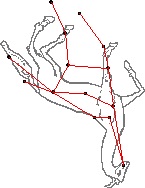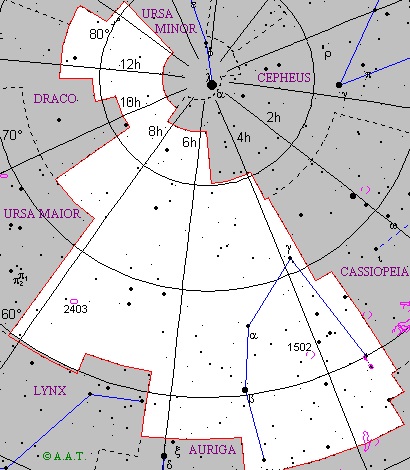
A Dutch astronomer Petrus Placinus and a German astronomer Jacob Bartsch created and described a large constellation in the northern hemisphere. It was Camelopardalis. Also known as the Giraffe, it is a large and faint constellation representing a giraffe and not a camel. It was created in those places which the Greek left empty because it did not contain any such bright stars that were brighter than the fourth magnitude. Jacob Bartsch used the shape of the void space which seemed like a giraffe, as the space itself had very dim stars and did not form any noteworthy shape. The constellation belongs to the Ursa Major family of constellations and can be seen during the month of February at 9 pm. Let us discuss Camelopardalis in detail.
There are numerous interesting stars in this constellation. Some of them are:
- Beta Camelopardalis: It is a binary star and also the brightest star in the constellation. With an apparent visual magnitude of about 4.03, it is approximately 1,000 light years distant from the earth.
- CS Camelopardalis: It is the second binary brightest star. The star is located about 2.9 arc seconds away and has a magnitude of about 8.7. Consisting of a blue–white B–type supergiant, it is approximately 3,000 light years away from the earth.
- Alpha Camelopardalis: It is the third brightest star of the constellation. It has been noted that this star is losing its mass rapidly.
- Gamma Camelopardalis: It is a white A–type sub giant
- Struve 1694: Also known as Sigma 1694 Camelopardalis, it contains 2 binary stars. It represents the head of the giraffe. It is composed of a white A-type subgiant with a magnitude of about 5.3 and is 300 light years away from the earth and the two A–type main sequence stars.
- BE Cameloparadlis: It is a red M–type bright giant star
Camelopardalis represents a giraffe, an animal which the Greek called the ‘leopard camel’, as it had spots like the leopard but neck like a giraffe. However, most of the times, the name is spelt as Camelopardalus or Camelopardus. This constellation was created by Petrus Plancius, a Dutch astronomer and was first illustrated by Jacob Bartsch, a German astronomer in the early 17th century.
It is believed that Camelopardalis contains quite a few prominent deep sky objects. They include:
- NGC 2403: It is an intermediate spiral galaxy and a member of Messier 81 group. This deep object is clearly visible from a medium–sized telescope. It is about 8 million light years distant and has an apparent magnitude of about 8.9. It was first discovered in the 18th century by a British astronomer Sir Frederick William Herschel.
- NGC 1502: It is an open cluster with two binary stars at its centre. Located at the end of the Kemble’s Cascade asterism, it contains about 45 stars, along with Struve 485 which is a bright binary star at the centre.
- IC 342: It is another spiral galaxy difficult to observe due to the dust around it. It has an apparent magnitude of about 9.1 and is 10.7 million light years distant from the earth. Generally, it is located outside the Local Group of Galaxies.
- NGC 2366: It is a small galaxy and has a magnitude of about 11.4.
- In addition to these, it also consists of a nebula NGC 1501 and NGC 2655 a small galaxy.
At latitudes between +90° and -10°, Camelopardalis is located in the second quadrant of the northern hemisphere.

It occupies an area of 757 square degrees, making it the 18th largest constellation in the night sky. The brightest star of this constellation is about 1000 light years away from earth. Hence, it can be said that the constellation is 1000 light years away from earth.
As discussed earlier, it does not have any mythological story associated with it. This constellation was invented to fill in the space between queen Cassiopeia and Ursa Major.
Camelopardalis borders Auriga, Cassiopeia, Cepheus, Draco, Lynx, Perseus, Ursa Major and Ursa Minor.

G Kowledge of | 0 Comments >>
0 Comments
Leave Comment
Your email address will not be published. Required fields are marked.